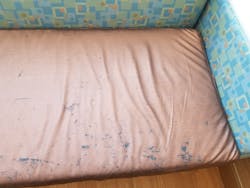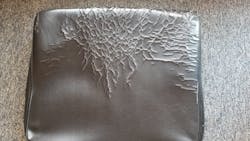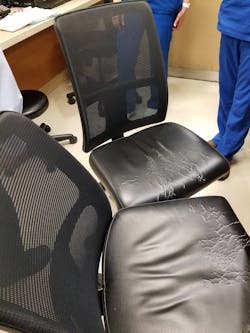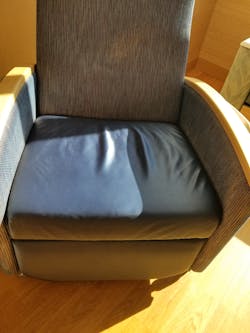The Time for Upholstered Fabric Performance in Healthcare Is Now
By Barbara Dellinger, Jane Rohde, Linda Gabel and Teri Lura Bennett
[Editor’s Note: This is Part 1 of a three-part series on durable coated fabrics.]
In 2017, riding the shuttle bus to Design Connections, an i+s event, a group of healthcare interior designers discussed their projects (and what kept them up at night) and realized many were having the same issues with durable coated fabric failures in their recently completed healthcare projects.
The group consisted of healthcare interior designers employed by healthcare systems and by firms specializing in healthcare design. Several were owners of their own design firms. The types of failures experienced with durable coated fabrics included:
- cracking
- crocking and reverse crocking (color transfer)
- stretching/puddling
- stickiness/softening
- peeling/delaminating
- fraying
- staining
- fading or loss of color
As a result of the failure, the furniture had to be disposed of, sometimes to a landfill as a biohazard because of contamination, and subsequently replaced. In some cases, the furniture manufacturer, the furniture dealership and/or the fabric distributor/manufacturer paid for the replacement costs. In other situations, the healthcare facility itself paid for the replacements.
We decided to dive deeper into the issues and to find solutions. Within the next few months, others were invited to collaborate with us, including those from fabric and furniture manufacturers, upholstery distributors, an environmental services and cleaning/disinfection expert, as well as those from several key trade associations. From these partnerships, the Durable Coated Fabric Task Group (DCF TG) was “born.”
History of the Problem
For the last decade, as super-bugs and their resistance to the disinfection products used to kill them have increased in use, hospitals have been prompted to use a wider variety of more aggressive disinfecting chemicals. The product used, coupled with a protocol to not rinse the disinfection chemicals off the surface of materials to extend the efficacy of these disinfecting chemicals, led to upholstery failures. Typically, fabric distributors have a disclaimer in their warranty that voids the warranty if the chemicals are not rinsed off with water after the application.
From a staff perspective, environmental services technicians do not have enough time allotted to honor the “kill time” of disinfectants and subsequently rinse surfaces with clear water, as required by manufacturer warranties. Staff often have 12 to 15 minutes to clean and disinfect an entire room and they struggle to complete the room turn-over within this limited amount of time, in addition to often-found staff shortages.
We also were seeing an increased use of chemical and material deselection lists (or “red lists”), which designers understandably have requested due to environmental and human health concerns. In response, durable coated fabric (DCF) manufacturers have offered compliant upholstery materials made of various formulations, substrates and topcoats. Unfortunately, this compounded the failure potential, as upholstery products were not being specified based on all performance characteristics required for healthcare environments. In addition, the durable coated fabric distributors responded to the designer requests for non-red list products by focusing on providing more eco-friendly products at a lesser cost, even if durability and other performance criteria were sacrificed to achieve the perception of a more environmentally friendly product offering.
- The impact of disinfection chemicals being used on an upholstery product
- The effect of chemistries used without rinsing
- Real-life circumstances of environmental service staff time constraints
Failure can result from one or a combination of the abovementioned circumstances, as well as the impact of a variety of environmental staining agents that have not been performance tested for upholstery fabrics used in healthcare settings. Further, with the onset of the pandemic, additional failures were noted because of the increase of use and/or change of disinfection chemicals used.
Failure of durable coated upholstery fabrics compared to the anticipated life expectancy of a chair or sofa, which ranges from 10 to 20 years, results in the overall piece creating potential infection control issues for the entire piece of furniture. Due to the issues described, upholstery has failed in a few years and sometimes even within a few months. The unsustainable result is tens of millions of dollars in losses being spent to reupholster or replace entire pieces of furniture and discarding failed furniture pieces that eventually end up in a landfill.
Unfortunately, these failures have been found not only in the United States, but also in healthcare facilities in Canada and throughout the globe.
Deeper Dive into the Issues and Collaboration
Frustration continued to grow, as we tried to compare testing information on the sample tickets (or memo sample tags) of durable coated fabrics. Testing information was inconsistent and often tests were called by varying names and/or did not include the same requirements. It was also not clear which tests had been performed on an upholstery material, as all test information was not always included on the sample ticket.
It was impossible from the sample information to truly understand the testing methods that had been completed and passed, which of the anticipated performance testing results were required to minimally meet the needs within a healthcare environment, and there was no standardization of performance testing used as a reference within the healthcare sector. Several designers began doing their own field studies to better understand performance, even though they were encouraged to leave the testing to the “labs” and the fabric manufacturers and distributors.
At this is the point in time, the necessity of a strong multi-disciplinary collaboration was essential to create a solution. Subsequently, many discussions took place to better understand the issues, the need for clarity about performance testing and identification of what type of performance testing is appropriate as a minimum baseline for healthcare specifications.
Discussions with trade associations, upholstery and furniture manufacturers and distributors, cleaning and disinfection chemical manufacturers, environmental services departments, researchers and technical experts—all sharing knowledge within the auspices of the Durable Coated fabric Task Group—started the evolution of a major market shift allowing for:
- Transparency between the groups noted above
- A new understanding of limitations of materials in certain applications
- Opportunities to innovatively change the way durable coated fabrics are performance tested and how this information is successfully conveyed to the specifier
Conclusion
The DCF Task Group has given many well-attended presentations at various national conferences, and as attendance grew, we knew our voices were being heard. With additional stories were shared, it was clear that something must be done.
As the Task Group shared more information and problems were collaboratively defined and verified, the Chemical Fabrics and Film Association (CFFA) heard us and developed a performance standard for the healthcare environment: Recommended Minimum Performance Standards for Vinyl Coated and Other Chemical Coated Upholstery Fabrics (CFFA-HC-201). The standard incorporates test methods used and evaluated over many years and were selected specifically for the CFFA- HC -201 standard to help prevent common product failures by incorrect selection.
The CFFA-HC-201 self-certification program for coated fabrics provides manufacturers and distributors of coated fabrics with a certification mark to help specifiers, designers and furniture manufacturers select appropriate coated fabrics for the HC environment. It requires that a coated fabric passes all 16 tests which relives the designer/specifier of gathering testing data, comparing results, etc. While it cannot guarantee that a coated fabric will never fail, it is a major first-step in helping designers make informed selections. There are currently nearly 200 hundred coated fabrics which have passed all 16 tests, which can be viewed here.
[Note: Part 2 of this three-part series will cover case studies, details on the development of the performance testing and additional information on selecting a product from a multi-attribute perspective.]
About the authors: Barbara A. Dellinger, MA, CHID, FIIDA, EDAC, MDCID, is a principal at Dellinger Consulting LLC; Jane Rohde, AIA, FIIDA, ASID, ACHA, LEED AP BD+C, GGA-EB, GGF, is a principal at JSR Associates; Linda Gabel, CHID, NCIDQ, is a senior planner at The Ohio State University Wexner Medical Center; and Teri Lura Bennett, RN, CHID, CID, IIDA, EDAC, NIHD, is a member of the AAHID Board of Directors and 2022 president.




